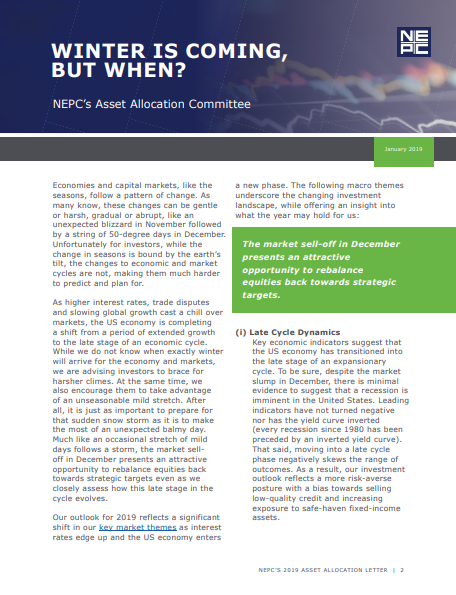Economies and capital markets, like the seasons, follow a pattern of change. As many know, these changes can be gentle or harsh, gradual or abrupt, like an unexpected blizzard in November followed by a string of 50-degree days in December. Unfortunately for investors, while the change in seasons is bound by the earth’s tilt, the changes to economic and market cycles are not, making them much harder to predict and plan for.
As higher interest rates, trade disputes and slowing global growth cast a chill over markets, the US economy is completing a shift from a period of extended growth to the late stage of an economic cycle. While we do not know when exactly winter will arrive for the economy and markets, we are advising investors to brace for harsher climes. At the same time, we also encourage them to take advantage of an unseasonable mild stretch. After all, it is just as important to prepare for that sudden snow storm as it is to make the most of an unexpected balmy day. Much like an occasional stretch of mild days follows a storm, the market sell-off in December presents an attractive opportunity to rebalance equities back towards strategic targets even as we closely assess how this late stage in the cycle evolves.
Our outlook for 2019 reflects a significant shift in our key market themes as interest rates edge up and the US economy enters a new phase. The following macro themes underscore the changing investment landscape, while offering an insight into what the year may hold for us:
(i) Late Cycle Dynamics
Key economic indicators suggest that the US economy has transitioned into the late stage of an expansionary cycle. To be sure, despite the market slump in December, there is minimal evidence to suggest that a recession is imminent in the United States. Leading indicators have not turned negative nor has the yield curve inverted (every recession since 1980 has been preceded by an inverted yield curve). That said, moving into a late cycle phase negatively skews the range of outcomes. As a result, our investment outlook reflects a more risk-averse posture with a bias towards selling low-quality credit and increasing exposure to safe-haven fixed-income assets.
(ii) Tightening Global Liquidity
In the last decade, liquidity stemming from accommodative monetary policies has been a major driving force of the global economy and capital markets. This is a pivotal year as the liquidity spigot tightens. From higher interest rates in the United States, to the Federal Reserve’s shrinking balance sheet, and dwindling bond purchases in Europe, central banks the world over are putting in place more restrictive policies today. This tightening of liquidity is a headwind for global credit and equity markets across the world. We believe the diminishing support from central banks warrants greater caution in credit markets as liquidity conditions remain fragile and will likely be tested by a flight from crowded credit positions.
(iii) China Transitions
China continues its immense and unprecedented transition in its economic, social, monetary and capital-market structures. The world’s second-largest economy is exercising caution over its monetary and fiscal policies as it attempts to manage indebtedness without popping its credit bubble. Throw into this complex mix an ongoing trade dispute with the United States, and the stakes have never been higher. Our base case remains a methodical recalibration of China’s economy. That said, uncertainties related to its trade squabble with the United States, tighter global liquidity and shifts within the US economy may expose structural weaknesses within China that will need to be carefully managed.
(iv) Globalization Backlash
We believe the uprising against globalization is a long-term trend, as populist movements across the world reject political and economic orthodoxy, and multilateral relationships are viewed with greater suspicion among nations. Years of building global supply chains, driven by cheap labor in emerging markets, advancement in automation and concentrated ownership of technology, widened the existing chasm of income inequality and fueled the loss of traditional middle-class jobs. These frustrations around globalization and the rise in populism have been in the making for over decades and thus, will take years to be fully reflected. These resentments have manifested themselves in the Brexit vote, many political elections and trade-policy negotiations, including the current trade tensions between the United States and China, the world’s two largest economies.
Our key market themes and asset allocation assumptions for 2019 suggest an investment playbook focused on getting more defensive. Also included in that playbook is the discipline of opportunistically rebalancing to targets. Our message to you: prepare your portfolio to withstand higher volatility and weather a waning economic cycle, but rebalance equities back towards long-term targets today so you can capture their recovery on the heels of the sharp drawdown in December. We believe diversification and disciplined rebalancing are critical to survive the transition into and through the late stage of an expansionary economic cycle.
Long-term actions for clients may include:
- Evaluating portfolios to ensure diversification and balance
- Adding defensive positions like safe-haven fixed-income securities in existing portfolios that have a bias towards growth and risky assets
- Focusing on long-term investment horizons and exercising discipline in rebalancing when the opportunity arises
- Staying committed to asset classes with robust return expectations such as emerging market equities
- Moving to market weights within developed market equities to minimize overweights to more fragile economies like Europe
- Recognizing that tightening liquidity could be a headwind for all asset classes, especially credit
- Acknowledging the potential for continued uncertainty around global trade and China’s role in the world economy
We anticipate a year of difficult transitions and higher volatility. Preparation is vital because winter is coming, even if we don’t know when. We are not only prepared to help you meet both these challenges, but also take advantage of the opportunities arising from the change in seasons. We also know that spring and then summer will eventually follow. We look forward to working with you through all the seasons to meet and exceed your long-term investment objectives.




